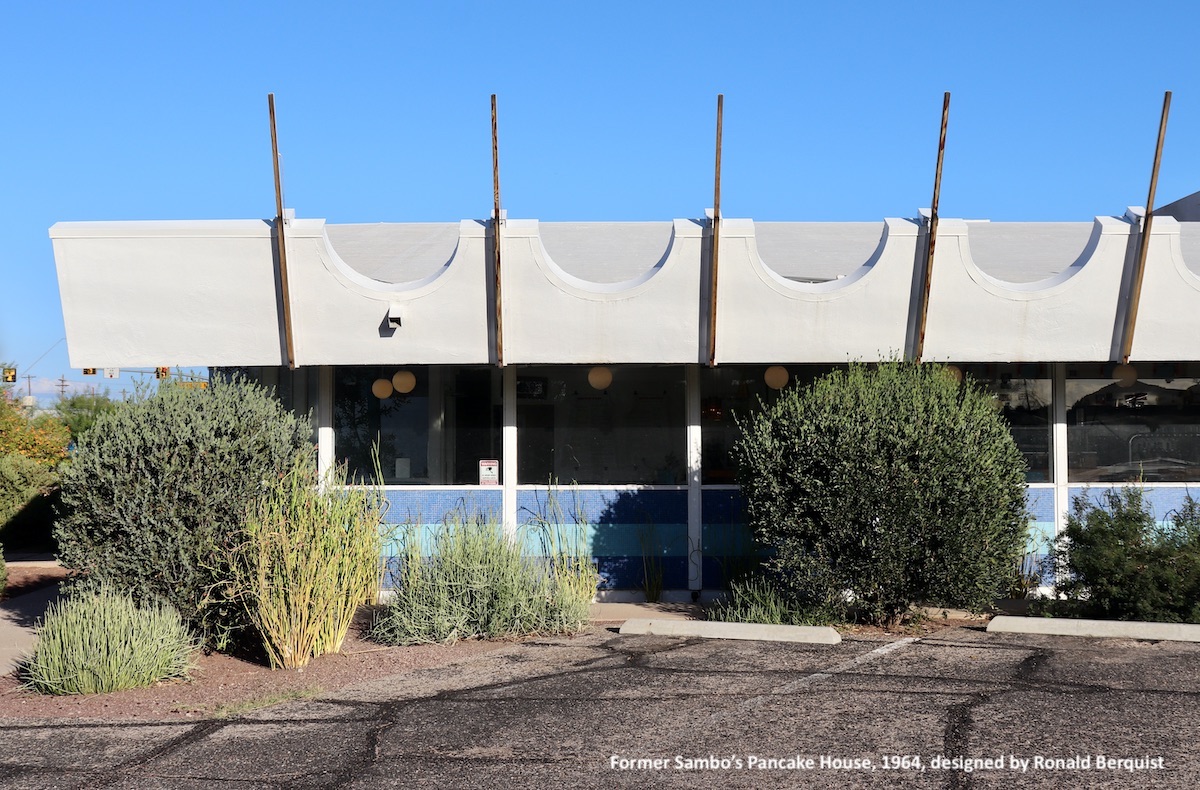
Midcentury optimism is alive and well in the Arizona desert
By Ken MacIntyre
(April 25, 2024) – Nestled amid the backdrop of the Santa Catalina mountains in the southeast corner of Arizona, Tucson stands as a living testament to a bygone era; a vibrant city that’s embraced a post-war past when architectural innovators and designers left their mark on the burgeoning desert community.
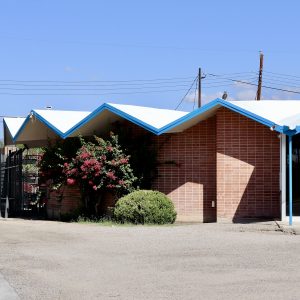
Former AAA Office, 1960
Back in the 1950s and ‘60s this new modernist movement was welcomed by Tucson’s expanding residential neighborhoods, by its business sector and especially by its growing tourism industry. Modern motels with elaborate neon signs illuminated the desert darkness while an optimistic spirit helped propel the city into the future.
Fast forward 50 odd years and, like most cities, some of Tucson’s post-war legacy is looking a little tired. Unlike most cities, however, Tucson’s Historic Preservation Foundation is hard at work rescuing and revitalizing much of its midcentury heritage. So, while places like Los Angeles continue to raze its modernist past despite a steady outcry from local preservationists, Tucson has taken a page out of the Palm Springs playbook and championed preservation.
On a recent visit I had the opportunity to explore many of the city’s midcentury districts including the historic Miracle Mile, Sunshine Mile, Tucson’s downtown core and more. Here are some of the highlights:
Miracle Mile
Once a thriving Strip of colorful neon signs and welcoming motor courts, this primary automotive route north of Downtown Tucson was added to the National Register of Historic Places in 2017. Its commercial corridor — connected to Tucson’s northern segment of U.S. Route 80, U.S. Route 89 and Arizona Route 84 — follows the alignment of North Stone Avenue, Drachman Street, Oracle Road and Miracle Mile.
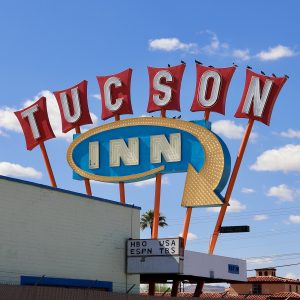
The Tucson Inn’s Googie sign, 1952
Some of this area’s standouts include the original American Automobile Association office designed by Arthur T. Brown in 1960 (a circular building that boasts a distinctive folded plate roof); the Hacienda Motel from 1956, which has two unique vintage neon signs out front; and a three block stretch of West Drachman Street (000-300) which features several restored and relocated vintage neon signs thanks to a Historic Preservation Foundation restoration project in partnership with Pima Community College. Also included in this stretch of pavement is the iconic Tucson Inn and its spectacular Googie sign which was designed by Anne Rysdale in 1952.
Sunshine Mile
This commercial Strip of remarkably intact midcentury modern buildings was one of the city’s first shopping areas just East of downtown when it was developed in the 1940s and ‘50s. Also known as East Broadway Boulevard, the Sunshine Mile was added to the National Register of Historic Places in 2020.

The Kelly Building, 1964
Running West to East, one of this Strip’s standouts includes a former Sambo’s Pancake House (pictured above) — designed in the Googie style by Ronald Berquist, c. 1964 — which was restored by Martha & Mary Studio, and Repp + McLain Design & Construction, and now goes by the name of Welcome Diner.
Other notable buildings in this area include the Kelly Building (1964) by architect Nicholas Sakellar, a sublime rectilinear office building which appears to float above its glass-enclosed ground floor; the Haas Building (built for the Desert Guild in 1957) designed by architect Anne Rysdale, which features a beautiful open steel staircase visible through a deceivingly simple two-story glass storefront; and the iconic Valley National Bank, now a Chase Bank branch, which resembles a sculptural art gallery more than it does a typical financial institution, designed by architect Don Smith in 1971.
Downtown
Like most cities, Tucson’s downtown core has several notable midcentury office towers including the Pima County Legal Services building (formerly the Tucson Federal building) built circa 1964-66; the Bank of America Plaza (formerly called the Arizona Bank Plaza) designed by Friedman & Jobusch and built in 1977; and the Pima County Superior Courts building, circa 1973-75.
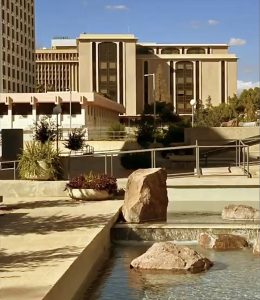
Garrett Eckbo’s Fountain Plaza, 1971-73
The real star downtown, though, is landscape architect Garrett Eckbo’s Convention Center Landscape (formerly called the Community Center), a large civic space built in 1971 and 1973 and consisting of three sections: Veinte de Agosto Park, the Walkway near former La Placita Center, and the impressive central Fountain Plaza which boasts stepped concrete terraces, shallow pools and desert boulders, all encircled by performance space buildings. This area was listed on the National Register of Historic Places in 2015 and is the largest remaining Garrett Eckbo civic design in the United States.
Neighborhoods
With names like Rose Hill Estates, Catalina Vista and Oracle Heights, Tucson’s planned residential subdivisions even sound like they were built in the midcentury. Both flat and angular rooftops, clean lines and large windows that blur the boundaries between indoor and outdoor living is what will greet you on a stroll through any of the city’s post war neighborhoods. In fact, there are so many of them that Tucson’s Historic Preservation Foundation created a 60 page color booklet to chronicle the more than two dozen districts. Entitled “Tucson: Guide to Mid-Century Neighborhoods,” it’s available digitally on the Foundation’s website.
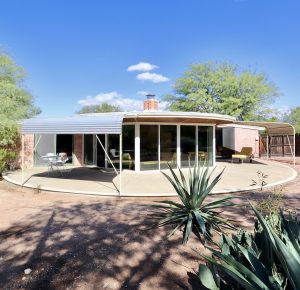
The Ball-Paylore House, 1952
One of Tucson’s notable midcentury modern homes, the Ball-Paylore House, designed by locally prominent architect Arthur T. Brown in 1952 for clients Phyllis Ball and Patricia Paylore, is owned by the Historic Preservation Foundation and available for experiential overnight stays. You can check it out at AirBnB.
Vintage Neon Signs
Amidst Tucson’s architectural marvels, vintage neon signs stand all over the city, like beacons illuminating the night. These eye-catching signs are not just relics of the past, but rather, living pieces of art each telling a story of a bygone time.
In addition to the many restored signs found on West Drachman Street, there are several still standing, both restored and not, “in the wild.” The vintage Color TV King sign at the corner of N Campbell Avenue and E Spring Street predates 1964 when Jack “the color TV King” Fitzgerald opened his remodeled TV store and became known locally for his enthusiastic television ads; the recently restored Mario’s Pizza biomorphic neon sign at 3157 N 1st Avenue originally opened as Marco’s Pizza in 1958 and was altered when new owners changed its name in the late ‘70s; and there’s a rare vintage “Norge Ball” sign at Dean’s Village Laundromat (2938 N 1st Avenue) which used to be part of the Norge Village Cleaners chain with over 3,000 U.S. locations in the late 1960s. Today there are said to be fewer than one hundred of these Norge Ball signs left in North America.

Mario’s Pizza vintage neon, 1958
You can also enjoy one-stop sign gawking at the Ignite Sign Art Museum (331 S Olsen Avenue), Jude Cook’s extensive personal collection from over 40 years of creating and restoring vintage neon.
***********
Tucson’s commitment to preserving its midcentury architecture and vintage neon signs is clearly evident in the efforts of organizations like the Tucson Historic Preservation Foundation. Through their initiatives they’ve ensured the city’s gems continue to stand as living monuments, captivating the imaginations of future generations.
Don’t miss Tucson’s Moderism Week which takes place every November. For details visit preservetucson.org/modernism-week
Writer’s note: the preceding recommendations are by no means the only mid-century treasures you’ll find in Tucson, Arizona. If you keep your eyes peeled, there’s lots more to discover. For more, be sure to visit the Tucson Historic Preservation Foundation website.
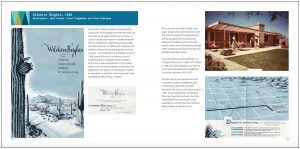
‘Tucson: Guide to Mid-Century Neighborhoods’ (detail), Tucson Historic Preservation Foundation
